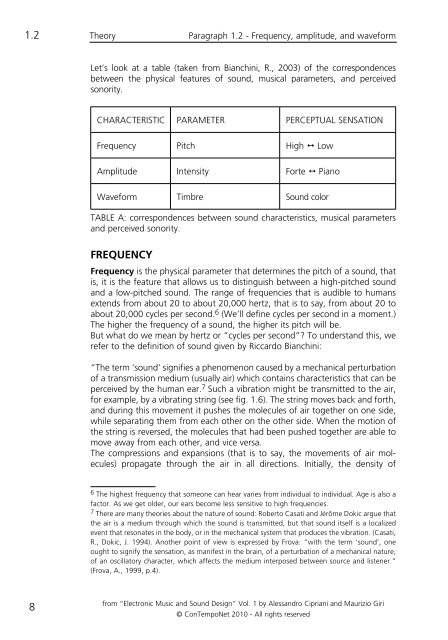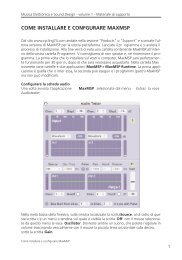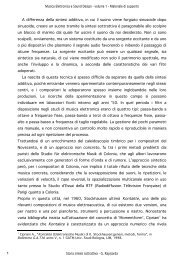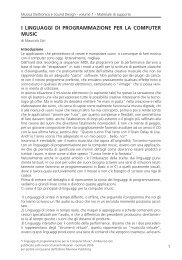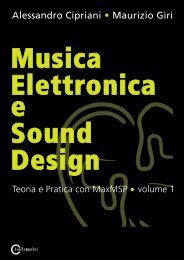programming with max/msp - Virtual Sound
programming with max/msp - Virtual Sound
programming with max/msp - Virtual Sound
You also want an ePaper? Increase the reach of your titles
YUMPU automatically turns print PDFs into web optimized ePapers that Google loves.
1.2<br />
8<br />
Theory<br />
Let’s look at a table (taken from Bianchini, R., 2003) of the correspondences<br />
between the physical features of sound, musical parameters, and perceived<br />
sonority.<br />
CHARACTERISTIC PARAMETER PERCEPTUAL SENSATION<br />
Frequency Pitch High � Low<br />
Amplitude Intensity Forte � Piano<br />
Waveform Timbre <strong>Sound</strong> color<br />
TABLE A: correspondences between sound characteristics, musical parameters<br />
and perceived sonority.<br />
FREQUENCY<br />
Paragraph 1.2 - Frequency, amplitude, and waveform<br />
Frequency is the physical parameter that determines the pitch of a sound, that<br />
is, it is the feature that allows us to distinguish between a high-pitched sound<br />
and a low-pitched sound. The range of frequencies that is audible to humans<br />
extends from about 20 to about 20,000 hertz, that is to say, from about 20 to<br />
about 20,000 cycles per second. 6 (We’ll define cycles per second in a moment.)<br />
The higher the frequency of a sound, the higher its pitch will be.<br />
But what do we mean by hertz or “cycles per second”? To understand this, we<br />
refer to the definition of sound given by Riccardo Bianchini:<br />
“The term ‘sound’ signifies a phenomenon caused by a mechanical perturbation<br />
of a transmission medium (usually air) which contains characteristics that can be<br />
perceived by the human ear. 7 Such a vibration might be transmitted to the air,<br />
for example, by a vibrating string (see fig. 1.6). The string moves back and forth,<br />
and during this movement it pushes the molecules of air together on one side,<br />
while separating them from each other on the other side. When the motion of<br />
the string is reversed, the molecules that had been pushed together are able to<br />
move away from each other, and vice versa.<br />
The compressions and expansions (that is to say, the movements of air molecules)<br />
propagate through the air in all directions. Initially, the density of<br />
6 The highest frequency that someone can hear varies from individual to individual. Age is also a<br />
factor. As we get older, our ears become less sensitive to high frequencies.<br />
7 There are many theories about the nature of sound: Roberto Casati and Jérôme Dokic argue that<br />
the air is a medium through which the sound is transmitted, but that sound itself is a localized<br />
event that resonates in the body, or in the mechanical system that produces the vibration. (Casati,<br />
R., Dokic, J. 1994). Another point of view is expressed by Frova: “<strong>with</strong> the term ‘sound’, one<br />
ought to signify the sensation, as manifest in the brain, of a perturbation of a mechanical nature,<br />
of an oscillatory character, which affects the medium interposed between source and listener.”<br />
(Frova, A., 1999, p.4).<br />
from “Electronic Music and <strong>Sound</strong> Design” Vol. 1 by Alessandro Cipriani and Maurizio Giri<br />
© ConTempoNet 2010 - All rights reserved


